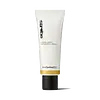What's inside
What's inside
 Key Ingredients
Key Ingredients

 Benefits
Benefits

 Concerns
Concerns

 Ingredients Side-by-side
Ingredients Side-by-side

Water
Skin ConditioningHydrogenated Didecene
Skin ConditioningGlycerin
HumectantMica
Cosmetic ColorantIsododecane
EmollientHydrogenated Polydecene
EmollientPropanediol
SolventPEG-10 Dimethicone
Skin ConditioningHydrogenated Styrene/Isoprene Copolymer
Sodium Chloride
MaskingPolyglyceryl-3 Diisostearate
EmulsifyingSodium Dehydroacetate
PreservativeCaprylyl Glycol
Emollient1,2-Hexanediol
Skin ConditioningSodium Phytate
Avena Sativa Kernel Extract
AbrasiveTamarindus Indica Seed Polysaccharide
Skin ConditioningTriethoxycaprylylsilane
Caesalpinia Spinosa Fruit Extract
Skin ProtectingSynthetic Fluorphlogopite
Kappaphycus Alvarezii Extract
Skin ConditioningAluminum Calcium Sodium Silicate
Phenoxyethanol
PreservativeAlcohol
AntimicrobialEthylhexylglycerin
Skin ConditioningPentaerythrityl Tetra-Di-T-Butyl Hydroxyhydrocinnamate
AntioxidantTin Oxide
AbrasiveTitanium Dioxide
Cosmetic ColorantIron Oxides
Water, Hydrogenated Didecene, Glycerin, Mica, Isododecane, Hydrogenated Polydecene, Propanediol, PEG-10 Dimethicone, Hydrogenated Styrene/Isoprene Copolymer, Sodium Chloride, Polyglyceryl-3 Diisostearate, Sodium Dehydroacetate, Caprylyl Glycol, 1,2-Hexanediol, Sodium Phytate, Avena Sativa Kernel Extract, Tamarindus Indica Seed Polysaccharide, Triethoxycaprylylsilane, Caesalpinia Spinosa Fruit Extract, Synthetic Fluorphlogopite, Kappaphycus Alvarezii Extract, Aluminum Calcium Sodium Silicate, Phenoxyethanol, Alcohol, Ethylhexylglycerin, Pentaerythrityl Tetra-Di-T-Butyl Hydroxyhydrocinnamate, Tin Oxide, Titanium Dioxide, Iron Oxides
Water
Skin ConditioningDimethicone
EmollientButylene Glycol
HumectantCetyl Ricinoleate
EmollientGlyceryl Distearate
EmollientTrisiloxane
Skin ConditioningGlyceryl Stearate Se
EmulsifyingCholesterol
EmollientSteareth-10
EmulsifyingSimmondsia Chinensis Seed Oil
EmollientCetyl Esters
EmollientCetyl Alcohol
EmollientTocopheryl Acetate
AntioxidantSodium Hyaluronate
HumectantCamellia Sinensis Leaf Extract
AntimicrobialMorus Bombycis Root Extract
Skin ConditioningPyrus Malus Fruit Extract
Skin ConditioningScutellaria Baicalensis Root Extract
AstringentVitis Vinifera Fruit Extract
Skin ConditioningCeramide Ng
Skin ConditioningCyanocobalamin
Skin ConditioningGlycerin
HumectantIsohexadecane
EmollientSilica
AbrasiveTin Oxide
AbrasiveSucrose
HumectantPolysorbate 80
EmulsifyingAcrylamide/Sodium Acryloyldimethyltaurate Copolymer
Emulsion StabilisingXanthan Gum
EmulsifyingCaprylyl Glycol
EmollientHexylene Glycol
EmulsifyingCitric Acid
BufferingLinoleic Acid
CleansingPanthenol
Skin ConditioningParfum
MaskingDisodium EDTA
EDTA
Magnesium Ascorbyl Phosphate
AntioxidantSodium Citrate
BufferingPhenoxyethanol
PreservativeSodium Metabisulfite
AntioxidantSodium Sulfite
PreservativeMica
Cosmetic ColorantCI 77891
Cosmetic ColorantCI 14700
Cosmetic ColorantWater, Dimethicone, Butylene Glycol, Cetyl Ricinoleate, Glyceryl Distearate, Trisiloxane, Glyceryl Stearate Se, Cholesterol, Steareth-10, Simmondsia Chinensis Seed Oil, Cetyl Esters, Cetyl Alcohol, Tocopheryl Acetate, Sodium Hyaluronate, Camellia Sinensis Leaf Extract, Morus Bombycis Root Extract, Pyrus Malus Fruit Extract, Scutellaria Baicalensis Root Extract, Vitis Vinifera Fruit Extract, Ceramide Ng, Cyanocobalamin, Glycerin, Isohexadecane, Silica, Tin Oxide, Sucrose, Polysorbate 80, Acrylamide/Sodium Acryloyldimethyltaurate Copolymer, Xanthan Gum, Caprylyl Glycol, Hexylene Glycol, Citric Acid, Linoleic Acid, Panthenol, Parfum, Disodium EDTA, EDTA, Magnesium Ascorbyl Phosphate, Sodium Citrate, Phenoxyethanol, Sodium Metabisulfite, Sodium Sulfite, Mica, CI 77891, CI 14700
 Reviews
Reviews

Ingredients Explained
These ingredients are found in both products.
Ingredients higher up in an ingredient list are typically present in a larger amount.
Caprylyl Glycol is a humectant and emollient, meaning it attracts and preserves moisture.
It is a common ingredient in many products, especially those designed to hydrate skin. The primary benefits are retaining moisture, skin softening, and promoting a healthy skin barrier.
Though Caprylyl Glycol is an alcohol derived from fatty acids, it is not the kind that can dry out skin.
This ingredient is also used as a preservative to extend the life of products. It has slight antimicrobial properties.
Learn more about Caprylyl GlycolGlycerin is already naturally found in your skin. It helps moisturize and protect your skin.
A study from 2016 found glycerin to be more effective as a humectant than AHAs and hyaluronic acid.
As a humectant, it helps the skin stay hydrated by pulling moisture to your skin. The low molecular weight of glycerin allows it to pull moisture into the deeper layers of your skin.
Hydrated skin improves your skin barrier; Your skin barrier helps protect against irritants and bacteria.
Glycerin has also been found to have antimicrobial and antiviral properties. Due to these properties, glycerin is often used in wound and burn treatments.
In cosmetics, glycerin is usually derived from plants such as soybean or palm. However, it can also be sourced from animals, such as tallow or animal fat.
This ingredient is organic, colorless, odorless, and non-toxic.
Glycerin is the name for this ingredient in American English. British English uses Glycerol/Glycerine.
Learn more about GlycerinMica is a naturally occurring mineral used to add shimmer and color in cosmetics. It can also help improve the texture of a product or give it an opaque, white/silver color.
Serecite is the name for very fine but ragged grains of mica.
This ingredient is often coated with metal oxides like titanium dioxide. Trace amounts of heavy metals may be found in mica, but these metals are not harmful in our personal products.
Mica has been used since prehistoric times throughout the world. Ancient Egyptian, Indian, Greek, Roman, Aztec, and Chinese civilizations have used mica.
Learn more about MicaPhenoxyethanol is a preservative that has germicide, antimicrobial, and aromatic properties. Studies show that phenoxyethanol can prevent microbial growth. By itself, it has a scent that is similar to that of a rose.
It's often used in formulations along with Caprylyl Glycol to preserve the shelf life of products.
Tin Oxide is an inorganic oxide used to add opacity and volume to a product. In nature, it is already found in mineral form. The main ore of tin is an opaque and shiny mineral called casseterite.
Tin Oxide helps remove translucency in a product, or make it more opaque. Besides adding opacity, tin oxide is used for bulking to add volume.
Water. It's the most common cosmetic ingredient of all. You'll usually see it at the top of ingredient lists, meaning that it makes up the largest part of the product.
So why is it so popular? Water most often acts as a solvent - this means that it helps dissolve other ingredients into the formulation.
You'll also recognize water as that liquid we all need to stay alive. If you see this, drink a glass of water. Stay hydrated!
Learn more about Water